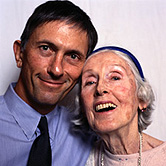
FRIDAY, Feb. 24 (HealthDay News) — About one-third of seniors still living on their own take a companion — usually a spouse or other family member — to their routine doctor’s office visits, researchers report.
And they tend to bring the same companion to each visit, which may present the health care system with another important member of a patient’s medical team, the study’s authors suggested.
“This raises some possibilities for quality improvement initiatives for patients and their companions together,” said lead study author Jennifer Wolff, an associate professor of health policy and management at the Johns Hopkins Bloomberg School of Public Health in Baltimore.
However, further research is necessary to define the companion’s role and figure out how to best support and include the companion in a loved one’s health care, she said.
For the study, the researchers looked at data from a nationally representative Medicare beneficiary study completed in 2006. This survey had information on almost 11,600 community-dwelling adults over 65 years old. The researchers also looked at a subset of more than 7,500 people from this group who had responded in 2005 and 2006 to determine the consistency of companion involvement.
The researchers found that nearly 19 percent of those who answered the survey were accompanied to physician office visits, and about 13 percent were accompanied to the doctor and received some sort of task assistance from the companion. That means a total of more than 31 percent took a companion with them to the doctor.
Twelve months later, three-quarters of these seniors were still accompanied to medical visits, almost always by the same person (88 percent).
Most of the time (about 93) these companions were family members, such as a spouse or adult child. Spouses were the companion more often than adult children.
The health of those who took a companion varied. A third reported being in excellent or very good health; another third said their health was good; and the final third reported being in fair or poor health, according to the study.
Most of those who took a companion (85 percent) were white, and many lived with either a spouse or an adult child.
For those who didn’t need assistance with scheduling or other tasks, transportation was one reason for bringing a companion 42 percent of the time. For those who needed assistance, transportation was one of the reasons 69 percent of the time.
Other reasons cited for having a companion present during a medical visit included providing information to the doctor, taking notes, asking questions or explaining a doctor’s instructions.
Results of the study were published recently in the Journal of the American Geriatrics Society.
Debra Greenberg, a senior social worker in the division of geriatrics at Montefiore Medical Center in New York City, called the study “a really nice beginning of an exploration of this topic.” But, she said, there was little variety in this particular population.
“I work with a very diverse population, and there are significant cultural differences that have to be addressed,” she said. “In some cultures, you just don’t talk about death and dying. And, some of the things we value as health care providers, like advanced directives and living wills, in some cultures, they think it’s complete hubris to say you have control over the end of life.”
She said that in a geriatric practice, physicians and other care providers often depend on reports from the people who accompany the older people to their appointments.
Wolff said there’s a need for more research into this area. For example, how best can companions add to the health care relationship? For now, Wolff said people should talk with their spouse or parents and ask what they hope to get out of their physician visits. They should also ask how they can help. Do they want you to help remind them of the questions they wanted addressed, or would they rather that the companion asked the questions? She said it’s helpful to set a framework for the appointment ahead of time.
More information
Learn more about involving loved ones in doctor visits from the U.S. National Institute on Aging.
